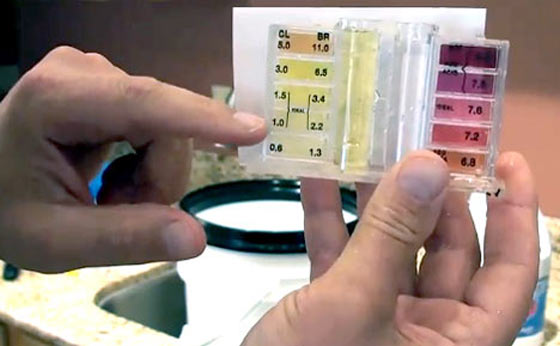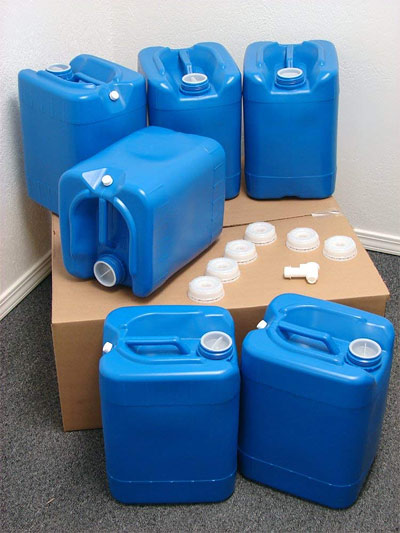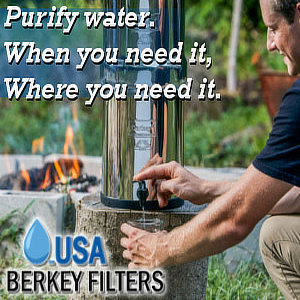Long Term Water Storage — 7 Tips How-to Do It Right

If you’re wondering how to store water long term, it’s not complicated. However, there are a few guidelines to follow for optimum results. What’s the result we’re looking for? Clean, safe drinking water when we need it!
Water is THE most important resource for survival. Period. We do take it for granted. There will always be a supply of clean pure water to drink, right?
I often hear the following questions:
“How long will water last if I store it?”
“How long until water goes bad?”
My short response to that is this:
Water is water, is water.
Water does not go bad in and of itself.
It’s mostly about the contamination that might get in (or already in) that can cause problems.
How long you can store water depends on if it’s contaminated to begin with, or if there are contaminants getting in, or environmental conditions are enabling organic contaminants to ‘grow’ in it.
UPDATED: 7 Guidelines…
Long Term Water Storage & How-to do it right
Follow these guidelines for successful long term water storage:
- Start with clean, pure water
- Use heavy-duty BPA-free water container(s) or barrel(s)
- Treat the water to assure elimination of organic impurities
- Store in a cool environment, ideally 50 – 70°F
- Keep out of direct sunlight
- Label ‘drinking water’ and the date
- Drain and Refill once a year (or every 6 months)
Water Source & Treatment
Usually the best source is municipal water from your faucet tap at home. It has already been treated with enough chlorine to destroy harmful organic pathogens. The level of municipal chlorine is typically measured at 0.5 – 1 ppm (parts per million) as tested with a swimming pool chlorine test kit.
For long term water storage, you might consider increasing this to 3 – 4 ppm to be assured of a maximum safe level for drinking (according to the EPA) to eliminate and prohibit growth of pathogens.
Once treated, and the chlorine has ‘done its job’, the level of chlorine will decay over time. That’s okay. Because a sealed container will prohibit contaminants from getting in.
You can test chlorine levels with these test strips, or any pool test kit:
Swimming Pool Water Test Strips
(view on amzn)

[ Read: Making Drinking Water Safe With Bleach ]
[ Read: Bleach-Water Ratio for Drinking Water ]
How To Store Water Long Term (The Containers)
A best way to store your water is in BPA-free heavy duty plastic containers that have been manufactured specifically for water storage. These containers are often colored blue, and often labeled as safe for drinking water.
You may also use pretty much any food-grade storage container. Just use a common sense approach to how and what you choose.
5 Gallon Samson Stackers
(view on amzn)

Or, perhaps a 55 gallon water storage kit:
Augason Farms BPA-free 55-gallon
(amzn)
Water Storage Environment
(Temperature)
Store your long-term drinking water storage containers in a relatively cool place. Avoid heat, which may promote growth of algae, etc. A good rule-of-thumb is ideally between 50 – 70°F.
I keep mine on the 1st-floor slab where it’s always cool. Some suggest to keep water containers from direct contact with concrete (long term). Perhaps setting on wood / boards. Personally, I’ve not had a problem.
(Dark)
Ideally, store the water containers in a dark environment. Reason being that sunlight will speed up the breakdown of chlorine level, and may promote organic growth.
The containers make a difference in this regard. Those that block more light than others (opaque containers).
Label It
I do this with my long term food storage too. I’m a big fan of (this) white artist tape. It sticks well, peels off easy, and great for writing a sharpie-pen label.
It’s so easy to simply label ‘drinking water’ and add the date that you set it up. Apply a new label/date when you renew it, six months or a year later.
Drain & Refill
Okay, this isn’t a huge deal. Water, is water, is water. It doesn’t ‘go bad’.
However, it’s always a good idea to drain and refill once in awhile. I do mine every year. Some suggest doing it every 6 months (nothing wrong with that).
The logic here is to assure a clean water supply. Also, the taste may become somewhat ‘stale’ after long term water storage. So, replenishing will help.
How much drinking water should I store?
FEMA says you should have at least a three-day supply of water and you should store at least one gallon of water per person per day. A normally active person needs at least one-half gallon of water daily just for drinking.
I say that you should assess your situation, your surroundings (do you have access to other water sources than tap water?), the number of people you’re storing for, your risk tolerance threshold, your risk assessment of what might affect you, and decide for yourself how much you would like to store.
50 gallons would be just about enough for 2 people for a month (bare minimum). And that doesn’t count all the ‘gray water’ that you normally consume (washing, sanitation, etc..), which amounts to LOTS more than you may think!
[ Read: The Average Gallons of Water People Use Each Day ]
How long will long term water storage last?
There are a multitude of opinions, but I’m sticking to this…
“Water is water, is water.” If you start with a pure clean source that’s known pure to begin with, or treated with a safe level of chlorine, and it’s stored in a clean sealed opaque container in a cool place out of direct sunlight, it will be drinkable for “a very long time”.
Water does not ‘expire’.
If it’s clean and pure to begin with, and you don’t allow contamination to enter, it will be safe to drink. The taste will become ‘flat’ after awhile, but that’s not critical. For maintenance, I would dump it and replace it once every year to be assured. I drain and replenish my water storage at least once a year.
ALWAYS Have A Quality Water Filter!
Lastly, I HIGHLY RECOMMEND having a quality countertop drinking water filter. As you likely know, I’m a big fan of the Berkey water filter systems. I recommend a very reputable and certified USA Berkey distributor, “The Berkey Guy”.

[ Read: Water Barrel Storage For Emergency ]
[ Read: Water Sources and Treatment ]
